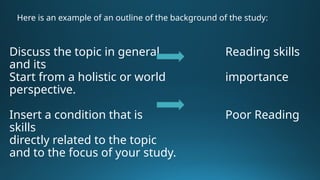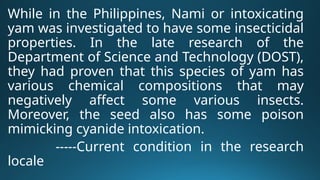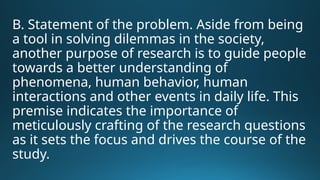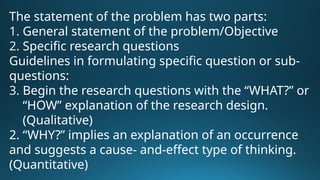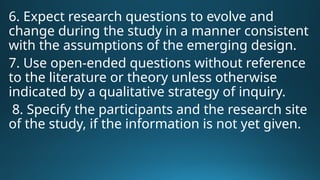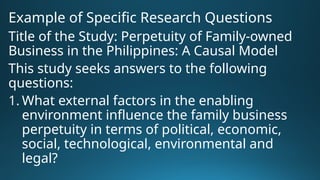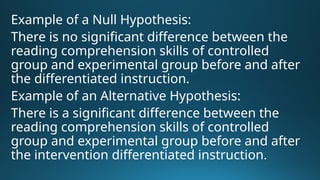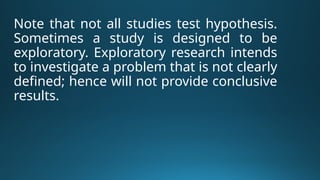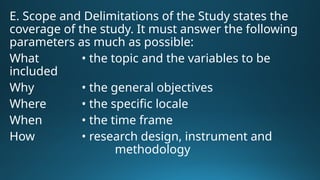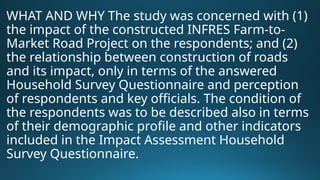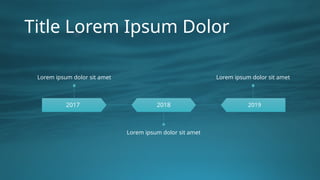Presentation 2-Identifying the Problem and Asking the Questions.pptx
- 2. After this lesson, you are expected to: 1. identify the following parts of a research paper: a. background of the study b. statement of the problem c. research hypothesis (for quantitative research) d. significance of the study e. scope and delimitation of the study f. conceptual framework g. definition of terms 2. describe the importance of each part of the research paper; and 3. formulate clearly the statement of the problem.
- 3. Activity 1: Identify the basic parts of a research paper described in each statement. Choose your answers from the word bank below and write them on your notebook. Introduction Notes in Chapter 1 Significance of the Study Definition of Terms Scope and Delimitation Conceptual Framework Statement of the Problem
- 4. This part… 1.serves as the plan or the blueprint of the study. 2. includes definitions of words operationally used in the study. 3. serves as an overview of the research topic under investigation. 4. sets the parameters of the study which narrow down the scope of inquiry. 5. states the concrete terms that a researcher expects to happen in the study.
- 5. This part… 6. cites the benefits certain groups of persons will get from the outcome of the study. 7. clearly expresses the specific direction or focus of the research problem or inquiry. 8. elaborates the origin of the research problem which led to the conduct of the study. 9. covers the general statement of the problem as well as the specific research questions to be answered in the study. 10. gives the concepts to be covered in the study as well as its boundaries in terms of the respondents/participants, sampling technique, locale and the research methods to be used.
- 6. One of the purposes of research is to address the pressing issues in the society. As a student who is a keen observer and is aware of the local, national or international affairs, list down three crucial concerns and propose a solution for each. For example: Problem 1 (Local): Diesel price hike Proposed Solution: Used Cooking Oil as a Substitute for Diesel
- 8. Review on the parts of Research A. The background of the study is an explanation of the context of study which involves the current data or status of the problem, existing studies about it and its history that paved way to the development of the research problem. It explicates the rationale why you, as a researcher, are conducting the study. Writing this particular part of the paper may lead you to your research questions. 1. It should clearly state the reason for conducting the study. 2. It should move from broad to specific. 3. It should state the current condition of the research problem.
- 9. Here is an example of an outline of the background of the study: Discuss the topic in general. Reading skills and its Start from a holistic or world importance perspective. Insert a condition that is Poor Reading skills directly related to the topic and to the focus of your study.
- 10. Identify the factors Factors Affecting Poor contributing to the Reading Skills in General focus of your study. State the current School’s Philippine Informal condition of the topic Reading Inventory (Phil-IRI) in your school or locale. result State the reason why Reason of the researcher you chose to study the topic.
- 11. Example of a Background of the Study Title of the Study: Nami Plant Extract as Termite Repellent According to Eiseman (2010) in his article which focused on termites, termites cause less than 75-80% of damage economically due to home, wood and crop infestation in North America. He stated that the reason is that termites are drawn to their food source and that makes them drawn to any type of wood like timber, logs, firewood and other wood made structures. He also added that termites can be harmful to humans due to its bites that may cause any allergic reaction. -----Discussion from a holistic or world perspective
- 12. Vulcan (2017) enumerated different tips that can help in preventing termites from eating wood and one of it is using a treatment like Rust Oleum, a named product used to paint wood to prevent termite’s infestation. This has been proven effective; however, the price is relatively expensive. -----A condition related to the topic or focus of the study
- 13. On the other hand, Onwueme (2016) published an article about an intoxicating yam named Dioscorea hispida. Yam is a root crop which contains poisonous alkanes that are harmful to human’s health. It can cause nausea and vomiting if its ripe fruit is ingested in the body. Although it has toxic content; it can be a source of food. Due to food scarcity and famine in some parts of the Philippines, this can be an alternative to rice given its abundance. Its toxicity can be removed once boiled. As described by Dukar (2012), intoxicating yam is a twining vine, arising from tuberous roots, and reaching a length of several meters. Juice of underground stems reported to possess narcotic properties. It is found in the Himalayas, from Nepal to Sikkim, at altitudes up to 1500m,
- 14. Mat (2013) conducted a study regarding Dioscorea hispida Dennst which is the Malaysian term for “yam.” In their previous ethnobotanical survey carried out on the Malay villagers in Pulau Redang, Kuala Terengganu district of Terengganu, it was found out that Dioscorea hispida tuber is used as food, traditional medicines to treat diabetes and shingle infestation, for de-worming as well as fish poison. On the other hand, the villagers of Sainnamari and Thanarbaid, Tangail, Bangladesh had used the poisonous tuber paste of Dioscorea as pois on in hunting. -----Factors contributing to the focus of the study
- 15. While in the Philippines, Nami or intoxicating yam was investigated to have some insecticidal properties. In the late research of the Department of Science and Technology (DOST), they had proven that this species of yam has various chemical compositions that may negatively affect some various insects. Moreover, the seed also has some poison mimicking cyanide intoxication. -----Current condition in the research locale
- 16. With this being said, the researchers aim to formulate a product with this intoxicating yam by disregarding its toxicity and instead using it as an advantage. The researchers intend to make a cheap, inorganic termite wood repellent. -----Reason of the conduct of the study Source: Ceejay S. Mallari, et al, “Nami Plant Extract as Termite Repellent” paper presented at Jose C. Payumo Jr. Memorial High School,
- 17. B. Statement of the problem. Aside from being a tool in solving dilemmas in the society, another purpose of research is to guide people towards a better understanding of phenomena, human behavior, human interactions and other events in daily life. This premise indicates the importance of meticulously crafting of the research questions as it sets the focus and drives the course of the study.
- 18. The statement of the problem has two parts: 1. General statement of the problem/Objective 2. Specific research questions Guidelines in formulating specific question or sub- questions: 3. Begin the research questions with the “WHAT?” or “HOW” explanation of the research design. (Qualitative) 2. “WHY?” implies an explanation of an occurrence and suggests a cause- and-effect type of thinking. (Quantitative)
- 19. 3. Focus on a single phenomenon or concept. 4. Qualitative research uses exploratory and non- directional verbs. The study will: discover (grounded theory); seek to understand (ethnography); explore the process of (case study); describe the experiences of (phenomenology); report the stories (narrative research). 5. Quantitative research uses directional verbs such as: affect; effect; influence; impact; cause; relation; relate; and determine.
- 20. 6. Expect research questions to evolve and change during the study in a manner consistent with the assumptions of the emerging design. 7. Use open-ended questions without reference to the literature or theory unless otherwise indicated by a qualitative strategy of inquiry. 8. Specify the participants and the research site of the study, if the information is not yet given.
- 21. Example of Specific Research Questions Title of the Study: Perpetuity of Family-owned Business in the Philippines: A Causal Model This study seeks answers to the following questions: 1. What external factors in the enabling environment influence the family business perpetuity in terms of political, economic, social, technological, environmental and legal?
- 22. 2. What internal factors in the enabling environment influence the family business perpetuity in terms of succession, planning, family stability, stewardship, family constitution, innovation, flexibility, philosophy of commitment, productivity-based management, governance power, and professional education? 3. What causal model best explains the perpetuity of family- owned business using the interplay and external factors? Source: Alaine Marc Goles, “Perpetuity of family-owned business in the Philippines: A causal model” Unpublished Doctoral Dissertation, University of Sto. Tomas, 2016.
- 23. C. hypothesis is a preconceived idea, assumed to be true and is tested for its truth or falsity. • Null hypothesis - indicates that there is no significant difference or relationship between specified populations or variables. It is the hypothesis the researcher will try to disprove or discredit • Alternative hypothesis - states that there is a significant difference or relationship between specified populations or variables Significant difference is used when testing whether there is difference between the means of two or more populations or variables Significant relationship is used in situations where one is
- 24. Example of a Null Hypothesis: There is no significant difference between the reading comprehension skills of controlled group and experimental group before and after the differentiated instruction. Example of an Alternative Hypothesis: There is a significant difference between the reading comprehension skills of controlled group and experimental group before and after the intervention differentiated instruction.
- 25. Note that not all studies test hypothesis. Sometimes a study is designed to be exploratory. Exploratory research intends to investigate a problem that is not clearly defined; hence will not provide conclusive results.
- 26. D. Significance of the study - pinpoints the benefits certain groups of people will gain from the findings of the study. It must start from the most to the least benefitted ones.
- 27. Example of Significance of the Study Title of the Study: Effects of Verbal Bullying to the Academic Performance of Grade 9 Students in Jose C. Payumo Jr. Memorial High School The result of this study will be valuable to the following: To the students, this will provide them knowledge about the forms of bullying and how to deal with it once encountered. To the school administrators, the result of this study may provide information and may serve as a basis to encourage them to make regulations about the
- 28. To the teachers, the findings of this study may help them to spread awareness on how destructive verbal bullying can be. Constant guidance from the teachers can also be an upshot of this study. Moreover, teachers may conceptualize activities or other solutions to create a positive and friendly atmosphere inside their classrooms. To the parents, this study may inform them on the possible negative circumstances like bullying that may happen to their children. As
- 29. To the future researchers, this study will serve as a basis for related topics. A continuation of this study may be done to fill in the gaps of this research that may result to proactive solutions to counter any form of bullying. Source: Jocelyn C. Gambas, et. al, “Effects of Verbal Bullying to the Academic Performance of Grade 9 Students in Jose C. Payumo Jr. Memorial High School, School Year 2019 – 2020” paper presented at Jose C. Payumo Jr. Memorial High School, 2020.
- 30. E. Scope and Delimitations of the Study states the coverage of the study. It must answer the following parameters as much as possible: What • the topic and the variables to be included Why • the general objectives Where • the specific locale When • the time frame How • research design, instrument and methodology
- 31. Example of Scope and Delimitation of the Study Title of the Study: An Assessment on the Impact of Farm-to-Market Road Projects in Pola, Oriental Mindoro WHERE This study was conducted in six Barangays of Pola, Oriental Mindoro, namely: Barangay Calubasanhon, Barangay Malibago, Barangay Maluanlaun, Barangay Pahilahan, and Barangay Pula. WHO The population considered was limited to those households who were directly affected by the constructed INFRES farm-to-market Road
- 32. WHAT AND WHY The study was concerned with (1) the impact of the constructed INFRES Farm-to- Market Road Project on the respondents; and (2) the relationship between construction of roads and its impact, only in terms of the answered Household Survey Questionnaire and perception of respondents and key officials. The condition of the respondents was to be described also in terms of their demographic profile and other indicators included in the Impact Assessment Household Survey Questionnaire.
- 33. HOW The study included an evaluation of the economic and social aspect of the beneficiaries before and after the INFRES farm-to-market road project, as well as of the respondents’ demographic profile, income and employment, improved access, and perceived benefits after the INFRES road was constructed. Key Informant Interview was also used to gather data, especially unanswered items in the survey. Source: Raynaldo Quitos, “An Assessment of Farm-to- Market Road Projects in Pola, Oriental Mindoro” Unpublished Master’s Thesis, University of Sto. Tomas, 2013.
- 34. F. Conceptual framework serves as an outline or a blueprint that you can follow in doing your research. It is presented in a flow chart, map, diagram or narrative form. When using a diagram, it is still a must to include narrative to explain the details. Here you show the variables that influence your research. Variable is anything that has quantity or quality that varies in a research. For example, if you are studying the COVID-19 outcomes, you might study home life, school and community. For school, your variables might be learning process and quality of learning. To make your conceptual framework thorough, it is encouraged to make it more detailed.
- 35. Step by Step Guide on How to Write the Conceptual Framework 1. Choose your topic. It should be within the field of your specialization. 2. Do a literature review. Go over relevant and updated studies related to your own research. Use reliable sources of information and use appropriate documentation. 3. Isolate the important variables. Identify the specific variables mentioned in the literature and show their interrelationships.
- 36. 4. Generate the conceptual framework. Build your conceptual framework using the variables studied in the scientific articles you have read. Your problem serves as a reference in constructing the conceptual framework. In effect, your study will attempt to answer a question that other researchers have not explained yet.
- 38. G. Definition of Terms lists down and defines the key terms as used in the study in alphabetical order. •An operational definition refers to a specific definition of concept in a research study. •This is necessary because it will clarify the purpose and direction of the study. •In order to enable better understanding of the study, the terminologies were operationally or conceptually defined.
- 39. Title Lorem Ipsum Dolor 2017 Lorem ipsum dolor sit amet 2018 Lorem ipsum dolor sit amet 2019 Lorem ipsum dolor sit amet








